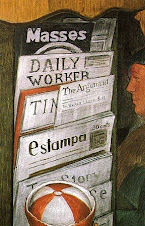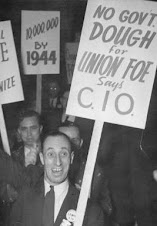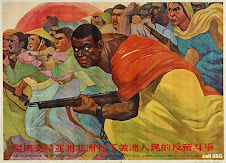
J.K. Rowling is a child of the 1960s, the age of rock and roll music, psychedelic drugs, and a political mass movement known as the “New Left.”
J.K. Rowling spent these years idealizing her hero, Jessica Mitford, a british teen who ran away from home to fight alongside Communists from around the world, in defense of the Spanish Republic against the rising menace of Fascism. As J.K. Rowling was reading Mitford’s writings, listening to the Beatles, and attending a prep school started by the abolitionist movement, her fellow youth were shutting down induction centers, burning their draft cards, campaigning to free Huey Newton, and rebelling in the streets of the world against Capitalism and Imperialism.
Harry Potter, the books and now popular series of films, is in many ways, a new left fairy-tale, full of the ideological thinking of student radicals of the period in which her thought was forged. One almost expects Harry Potter to be pull out a copy of Chairman Mao’s Little Red Book as he battles the forces of “pure blood”, “tradition”, and greed.
But the series also contains some of the New Left’s flaws; Flaws that continue to impact the radical movement of today, which emerges as the child of the generation before.
The Heroes

Our heroes before getting into specifics, are all young students at an elite Wizarding School. Throughout the books and films our young heroes disobey adults, challenge authority, and commit their acts of magical heroism as they sneak out of bed, steal potions, and scoff in the face of arbitrary authority figures who get in the way of what is right and just. No modern literary protagonists have said “Don’t Trust Anyone Over 30” louder than Harry Potter, Ron Weasley, and Hermione Granger.
Harry Potter, our main character, is born into a status of wealth and fame. Like Rowling’s generation of baby boomers, he is celebrated simply for his existence. He is looked up to for an act that he cannot even remember, killing the ruthless Lord Voldemort.
Harry is an heir to fortune of millions, but instead of living a happy wizard home-life, he is forced into living with a suburban, conservative, gosspy, and money obsessed family called the Dursleys. In their oppressive, “white picket fence” home, he is ridiculed for not being athletic and for not fulfilling the “normal” families ideal of what a child is supposed to be like.
These largely overweight, untrustworthy British suburbanites seem to be very incarnation of the “Labor Aristocrats” that 60s radicals spoke of when referring to the right-wing working class of the U.S. who “just couldn’t get with it” and be convinced by their radical views.
Several times the Dursleys rant in favor the death penalty and corporal punishment, making their reactionary politics clear.
However, upon becoming a teen, Harry is swept away into an underground society of Witches and Wizards with long hair, and brightly colored robes. This “counter-culture” is made up of magical people who hide beneath the radar of the modern world, building a society of their own, far superior to the old world of the fogies and straights whom they call: “muggles.”
Harry Potter has a sidekick named Ron Weasley, who is of low-income teen from a hard-working and morally pure proletarian family of redheads. Ron has Harry Potter to point him toward his emancipation, and lead him into battle with those responsible for his family’s conditions of poverty and exploitation.
And there is Hermione Granger, a smart, intelligent, young woman who struggles to prove herself through academics in a world where women are not supposed to be smart. Throughout the books she makes the occasional feminist speech, and in a one of the films she punches a bully in the face only to be cheered on for her “un-ladylike” act, defying the patriarchal norm of “girls don’t hit.”
And let us not forget Fred and George, the twin older brothers of Ron, who lampoon authority with pranks and satire, in a style that would make the Youth International Party and the Situationist pranksters of Haight Ashbury green with jealousy.
Yes, these characters seem not like the heroes of a children’s novel, but the biographies of the leaders of the Weather Underground Organization or the Berkeley Vietnam Day Committee.
The Enemy
And then there are the villains. The enemies of Potter and his gang, are a secret order amongst the rich called the “Death Eaters.” They wear drab clothes, and long for the greatness of an old Imperial England which is slipping away to the liberalism and promiscuity of tolerance and compassion. They seek to restore the “pure blood” of Wizarding people. They commit hate crimes against non-Wizards who they views as inferior.

These antagonists wear hoods over their faces as they travel in mobs committing crimes against the helpless, and when they roam the world they wear outfits might one expect from those attending a party at Castle Dracula on St. George’s Eve.
Voldomert, their violent authoritarian leader, has been defeated. Yet in the shadows he is secretly returning. When our heroes sound the alarm, society dismisses them simply as insane wild youth. But they continue daring to tell the truth to a world which does not wish to hear it. They persevere in their battle for what is right, no matter how harshly they are slandered by the “vultures” of the Daily Prophet, the mainstream newspaper of the Wizarding world.
In the fifth installment of the novels they find their soapbox in the beloved Alternative Press called “The Quibbler.” (This section was not in the film version, however.)
Other New Left Themes
The story line is so obviously a New Left fairy-tale allegory, we need not look to deeply. How more obvious can it be? A group long haired free thinking people in robes who are outcast from a dull and drab society, battle a group of dark, power-hungry, bigots who hate happiness and freedom, and worship money and the traditions of the past.
When Hermione forms an organization for the liberation of the House Elves, small little creatures who serve the Wizards, they reject her. Hermione’s attempt reminds me of what happened when groups like the Progressive Labor Party and the Revolutionary Union went into the U.S. factories, selling Challenge and Revolutionary Worker at the factory gate before their shifts began. These idealistic young intellectuals were not to be greeted by their fellow workers as liberators, but rather told to “go back to Russia”, and greeted with “Look, here comes Ho Chi Minh”, by the very working class they sought to liberate from the tyranny of the bosses.
The moralist rhetoric of the New Left bleeds through particularly in the second film. When Harry Potter turns to the headmaster, with his fears that he is “destined” to be in Slytherin, a section of the school of Wizardry associated with evil, his wise educator informs him “The choices we make are more important than any destiny we have.”
Jean-Paul Sartre, Althusser, Bill Ayers, Herbert Marcuse, all voiced this loud philosophical leap of the New Left, replacing Dialectical Materialism with Existentialist Moralism. Yes, people’s behavior is a product of their environment, the New Left proclaims in agreement with Marx. Yet, they ad a postscript that justifies their moralist and non-economically based activism: “unless we become enlightened and decide not to be.”
Harry Potter and his team of young rebels, like the children of the New Left, and unlike the radical movements of the 1930s and prior, is not driven by a desperate need for bread, jobs, or employment. Rather, Harry Potter is driven by the same force that drove Bill Ayers, Mark Rudd, and seemed to scream out of each of the ads that “World Can’t Wait” put in the New York Times during George W. Bush’s presidency.
Harry Potter is driven by moral outrage, alienation, and the drive to be “right in his soul,” as Anna Louis Strong called it, by giving up his comfortable life to do battle with injustice.
Harry could just as easily join the forces of evil and enjoy the privileges and power of his birth and class standing, but because of his morality and alienation he driven to the side of the oppressed, where he views himself as their triumphant defender and battle-commander.
Conclusion
Harry Potter is the fairy tale of a different left in a different time. The movement of the 1960s white student left was led by college students, who disliked the status quo and the Vietnam War and sought to break with the conservative ways of their parents. They longed to have a good time, to get “turned on”, to “drop out” into a world of their own. They sought to morally demonstrate to everyone else about why U.S. Society was immoral, violent, alienating, and disgusting.
Harry Potter is a representation of the baby-boom radicals, who gave up lives of luxury to stand on street corners selling Revolutionary Worker, The Militant, and New Left Notes hoping to enlighten the broad masses about the evils of their society, only to be dismissed as lunatics by the “uptight” “fat” working class of the U.S. which was still enjoying the crumbs of imperialist wealth.
Like Harry Potter, some of these young radical formed groups like Potter’s “Defense Association” from the fifth installment, where they learned to fire handguns, and even planted pipe bombs in draft offices and ROTC buildings. The new left radicals did not have faith in the working class to make a revolution, so many resorted to failed adverturist attempts to spark it themselves with anarchistic terrorism.
The era we live is greatly different from the scenario presented to us in Harry Potter’s exploits. We live in a time when the working class is far from content, but suffering in an economic collapse and ready to hear what Marxists have to say about putting an end to unemployment, poverty, and starvation.
In our current time the goal is not to “get turned on” and “drop out” to build a society of our own on a new code of ethics, but rather to fight against the rich and powerful together with the entire working class, and build a society for all that works for the good of everyone.
Harry Potter is by no means void of value in modern times. Perhaps the youth who confusedly rallying behind Ron Paul’s call to “Restore the Republic” should think of the Death Eaters and their fantasy of restoring the past while loathing reforms.
Those who turn toward Randian Libertarianism and its “Virtue of Selfishness” should take note that the evil Lord Voldemort tells Harry there is “no good or evil, only power and those who seek it.”
In terms of who the enemy are (conservative, greedy, bigots who long for the past) and who the heroes are (students, workers, and oppressed people), Rowling’s allegorical novel is right on. However, when it comes to the forces that motivate the battle for our future, she reflects the battles of another period in history, very different from our own.
It says a great deal that the Harry Potter books, with its overall leftist message have been so embraced by my generation. This is perhaps a sign that the horizon contains many happy endings and celebrations, which will make the fairy-tales of the middle-ages seem dull and depressing.










































No comments:
Post a Comment